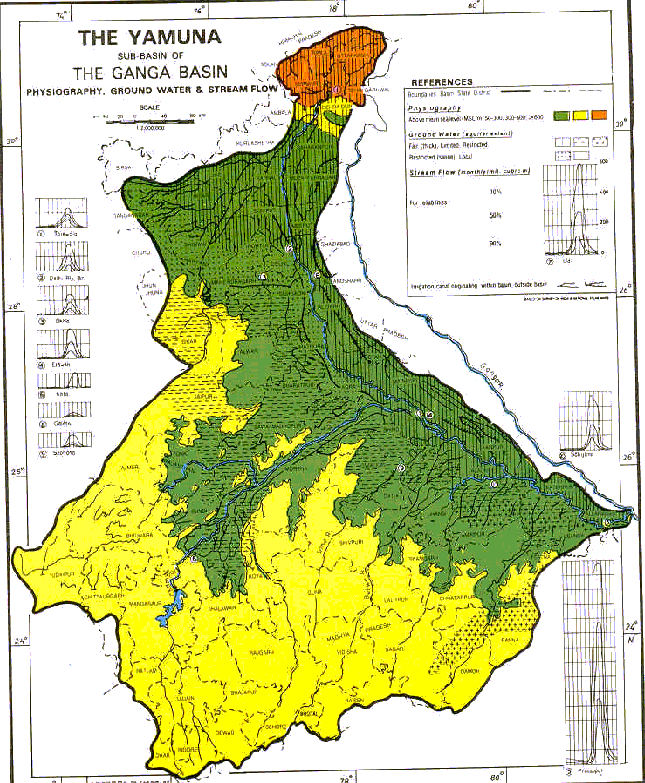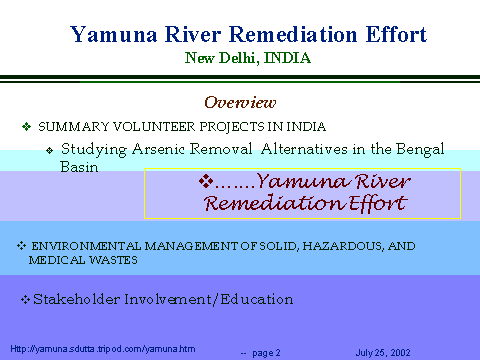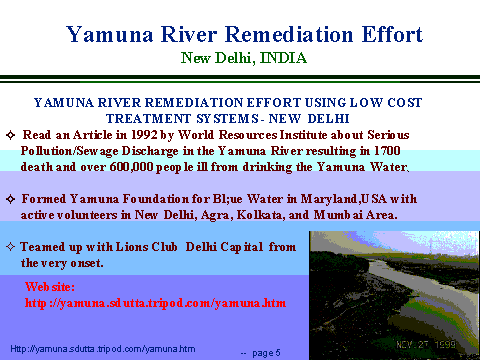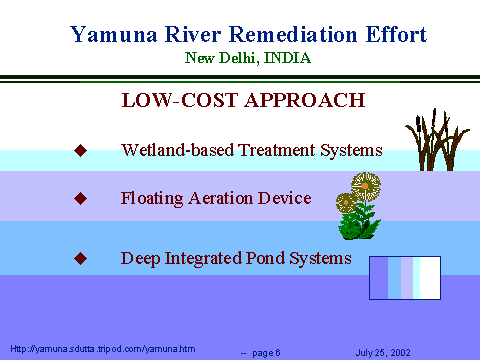
|
Ganga-Yamuna Remediation Options & StrategiesSummary Report, (Ganga-Yamuna) Conference, New Delhi, July 25, 2002Enveloped in a sizzling summer environment with water level hitting a 15-year low at the Yamuna river, the Ganga-Yamuna Conference drew the water hearts of this capital city and many other dedicated individuals from Agra, Kolkata, Lucknow, and Mumbai. The Lions Club of Delhi Capital, District 321 A1, outnumbered all other organizations, including the Jawaharlal Nehru University (JNU), in the total head count from one single organization at this conference. The conference was audaciously opened by Lion Jittender Kapoor in a air-cooled environment of the School of Arts and Sciences auditorium of JNU. Mr. Kapoor introduced the guest of honors, and the speakers. Prof. Kasturi Dutta, Dean, School of Environmental Sciences, JNU made a striking opening remarks and urged the participating organizations involved in the Yamuna cleanup to amalgamate their energy to solve this complex pollution problem of the Yamuna river in a cost-effective way. Dr. R.C. Trivedi from the Central Pollution Control Board (CPCB), New Delhi, presented the status of the Yamuna river and historic water quality records of different segments of the Yamuna river. In his presentation, Dr Trivedi had carefully analyzed the water quality status of the following sectors of the Yamuna river:
Actual water quality results, as monitored by the CPCB, were concisely presented by Dr. Trivedi. To provide a proper perspective the physiography, groundwater, and stream flow of the Yamuna sub basin of the Ganga basin is shown on Figure 1 (Source: Yamuna Action Plan, 1985). Dr. Brij Gopal from JNU took the podium after Dr. Trivedi and emphasized the need for conservation of rivers and floodplains in India. Dr. Gopal stated the need for even simple awareness of the rapid deterioration of the water quality of rivers and lakes in India is an important step. He stressed upon the following issues:
Figure 1. The Yamuna Sub basin of the Ganga River (Source: Yamuna Action Plan, 1985)
Mr. Subijoy Dutta from Maryland, USA addressed the enchanted audience thereafter with a summary of his effort on Yamuna river remediation since 1992. Mr. Dutta covered the following topics in his presentation:
Mr. Dutta touched upon the following facts and figures in his presentation:
Details of the above three options were presented by Mr. Dutta. The floor was then opened to Questions and Answers and a Panel Discussion chaired by Mr. Subijoy Dutta with Dr. Brij Gopal and Dr. R.C. Trivedi on the panel. Various questions and issues were raised in the panel discussion. Dr. Aradhana Mehra, who completed her PhD from JNU, raised the issue of cost-effective treatment systems. She asked why constructed wetland systems are not given appropriate consideration in treating sewage discharges in India. Mr. Dutta responded to her question and mentioned that the very first proposal that was submitted by him to the Delhi Jal Board contained a passive (subsurface flow) constructed wetland system, which needed only 2.3 acres to treat one million gallons per day (MGD) of wastewater. Site-specific design of the constructed wetland system was prepared for the Khyber pass drain near Aruna Nagar pumping station. Prof. D.K. Banerjee, ex-Dean of the School of Environmental Sciences at JNU also commented on the issue and recommended usage of constructed wetland systems. Dr. R.P. Singh, from the St. Johns College, Agra raised the next question about monitoring water quality of the Yamuna river near Agra and possible help/support of their advanced chemistry laboratory in Agra. Mr. Dutta accepted the idea and indicated that he would visit the Yamuna sites in Agra and the Laboratory. There were four more questions and issues raised by the audience which did not focus remediation strategies and options. A light refreshment was hosted by the Lions Club after the Conference. During the get-together, Lion S.K. Anand invited Mr. Subijoy Dutta to take a look at the Vasant Vihar complex and possibly suggest an independent wastewater treatment system for this locality of about 5,000 people. Mr. Dutta agreed to follow it up within the next few days.
Best viewed with Mozilla Firefox web browser.
|
Note: Rivers of the World (ROW) Foundation is a Tax-Exempt(501(c)3)Organization. All contributions to the ROW Foundation (Fed. Tax ID 26-062-3120 )qualify to be deductible from U.S. income taxes. All Rivers of the world foundation team members are participating in the Rivers/Stream restoration and protection activities on their personal time and contributing their personal funds. Not a single volunteer of the Foundation is receiving any compensation, rather they are paying towards the cause. They are conducting the activities in compliance with applicable regulations (US 18 U.S.C. 207 , 5 CFR 2635, and others; India - IPC for Ethics) in their respective countries. They are dedicated to Restore/Protect Rivers/Steams of the World and provide clean water for the poor and needy. |




